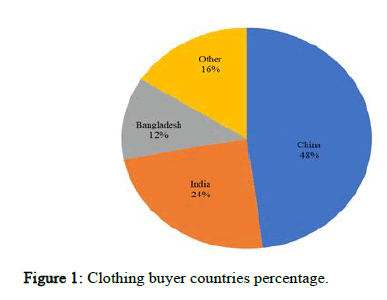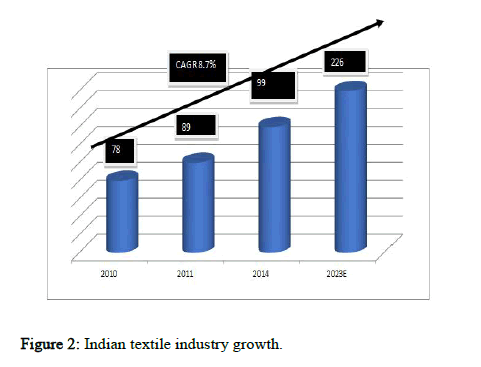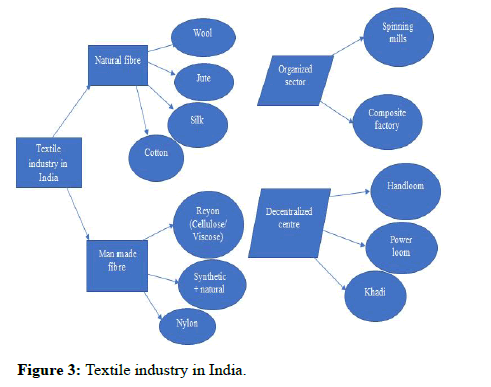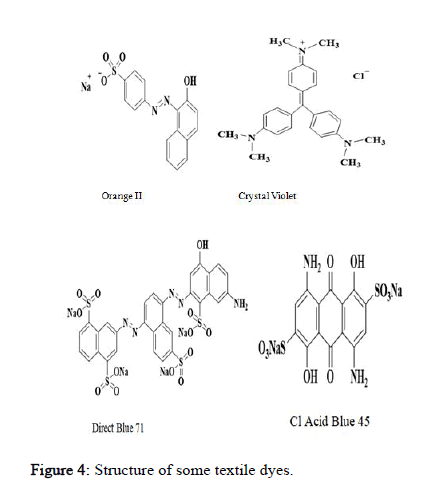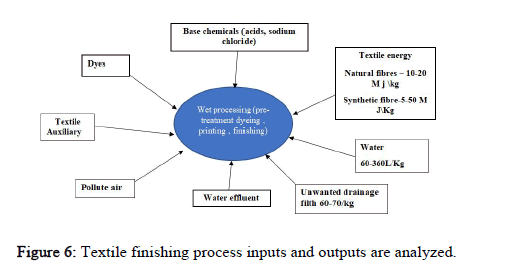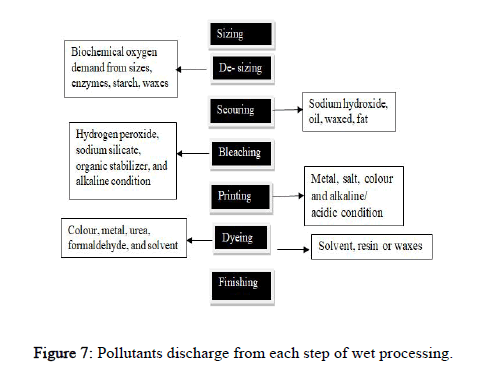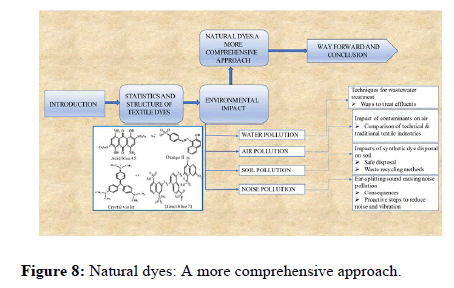Review Article, J Fashion Technol Textile Vol: 10 Issue: 10
Environmental Impact assessment of textile industries: control measures, disposal, recycling and future perspectives: A review
Suresh Kumar* and Priyanka Sati
Department of Chemistry, Banasthali University, Rajasthan, India
*Corresponding Author: Sudesh Kumar
Department of Chemistry,
Banasthali
University,
Rajasthan,
India,
Tel: 8193989818;
E-mail: satipriyanka789@gmail.com
Received date: 21 June, 2022, Manuscript No. JFTTE-22-67310; Editor assigned date: 24 June, 2022, PreQC No. JFTTE-22-67310 (PQ); Reviewed date: 08 July, 2022, QC No. JFTTE-22-67310; Revised date: 29 August, 2022, Manuscript No. JFTTE-22-67310 (R); Published date: 07 September, 2022, DOI: 10. 4172/2329-9568.1000278
Citation: Kumar S and Sati P (2022) Environmental Impact Assessment of Textile Industries: Control Measures, Disposal, Recycling and Future Perspectives: A Review. J Fashion Technol Textile 10:10.
Abstract
Textile industry is a very significant and rapidly growing manufacturing sector and it produces a huge amount of textile effluents becoming the chief cause of water, air, soil and noise pollution. Fabric industrialized sector such as spinning and weaving segment produces ear splitting sound and these are causing audible range trouble to the labour. Textile manufacturing liberates CO and CO2 gases in air which are significantly contaminating the atmosphere. The fabric production procedure consumes large amount of water, energy and various chemicals. The main difficulty concerning the water utilization is the unprocessed squander sewage which is straight released into the water bodies. Textile industry is answerable for the key ecological contamination trouble all over planet, because they liberate unwanted dye sewage. Some approaches have also been addressed in this article which has the potential to mitigate the environmental hazards originating from textile effluents to some degree. Natural dyeing is mentioned as a replacement to synthetic dyes that is both environmentally compatible and cost efficient.
Keywords: Textile industry, Effluent, Contamination, Manufacturing, Ecological, Technologies, Eco friendly ways
Introduction
India currently holds the position of third largest textile producer worldwide, and the world's second most cotton and yarn producing nation. It has a profound impact on the international cotton and textile markets. After China, India is the world's largest clothing buyer.
Textile industry is one of India's earliest and widespread industries, as well as the country's second largest employer after agriculture, employing nearly 35 million people. Interestingly, this industry contributes all over 4% of GDP, 14% to industrial output, 9% excise collection, 18% industrial employment, and 16% to the entire export income underscores its significance (Figures 1-4).
The export of textile and clothing products including handicrafts from India has increased slightly to US dollar 40.4 billion registering a growth of 3% during 2017-18 from US dollar 39.4 billion during 2018-19 (Table 1) [1].
| Products | Units | Apr-August | Apr-August |
|---|---|---|---|
| Fabric | Kgs | 34572.13 | 58899.18 |
| Sqm | 662033.4 | 816516.2 | |
| Yarn | Kgs | 443083.6 | 389019.2 |
| Made up | Kgs | 146050.8 | 164959.2 |
| Nos | 39183.66 | 33242.43 | |
| Sqm | 65.59 | 74.13 | |
| Fibre | Kgs | 161969 | 163256.2 |
Table 1: Synthetic fibre export during April 2019-20.
Textile manufacturing procedure
• Production of fibres
• Processing of yarn
• Fabric development
• Before-hand treatment
• Printing and dyeing
• Treatment for the end result
• Fabrication
The first step in this chain is the production of the fibres and the fibres are divided into two categories:
• Natural fibre
• Man made fibre or synthetic fibre
The natural fibre can be classified on the basis of their source, like cellulose (from plants), Protein (from animal), and cotton (from seed hair), stem fibre such as linen, sisal (from leaf), coir (from coconut), silk (from secretions) (Figure 5). Man made fibre also known as synthetic fibres are generally divided into two types:
• Viscose
• Cellulose based fibre
Process
• In the first step, seeds and other components such as capsule fragments, leaves, and twigs are separated from the fibre.
• In the second step, fibre is converted into a uniform fibre band with the help of carding machine and this fibre band is known as silver band.
• Various spinning technologies have been established in the industrial sector and by this process formation of yarn takes place.
• Formation of fabrics takes place with the help of weaving or knitting process.
• The final step is the production of textile products [2-4].
Literature Review
Environment impact
The clothes are made from raw materials viz. cotton, flax, and hemp, which consumes ample amount of water. Cotton plant requires a hefty amount of water to survive and to preserve these precious crops; several farmers use plenty of pesticides and herbicides, which are harmful to our climate.
According to a report published in science news in 1991, the amount of nitrous oxide in the atmosphere increased by 0.2 percent each year, with 0.0002 percent coming via nylon along with polyester processing. Nitrous oxide is a potent greenhouse gas with 300 times the ability to deplete the stratospheric ozone layer than carbon dioxide [5]. In textile production chain, the wet process is the important part of toxic emission [6]. The principal garments organisation countries for whole world are China, India, Bangladesh, Indonesia and Cambodia (Figure 6) [7].
There are four main types of contamination
• Water contamination
• Air contamination
• Soil contamination
• Noise contamination
Water pollution
Textile industry wastewater shows toxic effects on aquatic macrophytes and algae [8]. Quality of water is usually determined by the rate at which a product in an aqueous solution degrades [9]. Millions of gallons of water per day used in industries. The problem is not the excessive use of water, but the problem is that contaminated water is released into the environment without treatment. According to a report, the textile industry is responsible for 20% of all freshwater emissions (Table 2) [10,11].
| Number | Process | Discharge of Chemicals | Contaminants | Health effect |
|---|---|---|---|---|
| 1 | Singe | Benzene, starch | Resin, wax, glucose and starch | Carcinogenic, mutagenic and effects central nervous system |
| 2 | Achromatizing | Hydrogen, NAOH, Detergent | Crude wax, caustic, sodium silicate | Effect kidney and liver |
| 3 | Dyeing | Sulphate, Urea | Dyes, sulphate, urea | Eye and respiratory problems |
| 4 | Printing | Nitrate, phosphate, dyes | Starch, gum, pva pigment, colour | Harmful health hazard’s |
| 5 | Finishing | Fats, silicone | Starch, finishing agent | Suppression of haematological system. |
Table 2: Effect of pollutants on health.
Two processes are involved in the production of fibre (Figure 7) (Tables 3-5).
| Types of industry | Production, tones/day | Water waste m3/day |
|---|---|---|
| Composite industry cotton, synthesis | 10.63 | 840 |
| Synthesis | 2.6 | 180 |
| Refining | 1.61 | 150 |
| Whisking | 16.66 | 1500 |
| Woollen industry | 8.5 | 2700 |
| Woollen | 3.3 | 700 |
Table 3: Quantity of waste water generated by textile industry in India.
| S. NO. | Result | Amount |
|---|---|---|
| 1 | Jean | 30-35 L/ meter |
| 2 | Shirt part | 11 L/meter |
| 3 | Slacks | 80 L/meter |
| 4 | Weaving textile | 90 L/Kg |
Table 4: Amount of H2O required.
| S. No. | Boundary | Degree |
|---|---|---|
| 1 | pH | 6.9 ppm |
| 2 | BOD | 30 ppm |
| 3 | COD | 250 ppm |
| 4 | TDS | 2000 ppm |
| 5 | Sulphide | 2 ppm |
| 6 | Chloride | 500 ppm |
| 7 | Calcium | 75 ppm |
| 8 | Magnesium | 50 ppm |
Table 5: Textile manufacturing boundary for water contamination.
• Dye process [12].
• Wet process.
Ways to treat water effluent from textiles
To reduce the textile water pollution these techniques are proving to be useful.
• Biological approaches
• Chemical procedure
• Physical methods
Biological approach: The biological method can only discard the soluble impurities, the biological systems is categorised in two different categories on the basis of oxygen needfulness.
• Aerobic
• Anaerobic
• Facultative
Chemical procedure: Organic compounds are usually removed using chemical methods such as flocculation and coagulation. [13,14]
Physical method: The physical procedure are soil purification or carbon adsorption, the method of carbon adsorption gives a result to reduce additional than 50% from COD, also to exclude surface active and manufacturing from staining.
Following are some textile wet processing innovations that are on rise and has significant environmental and other benefits:
• Dyeing using supercritical CO2
• Textile wet process with plasma technology
• Bleaching cotton fabrics with ozone
Some other Techniques for wastewater treatments
Primary
• Showing
• Alleviation
• Homogenisation
• Nullification
• Motorised flocculation organic flocculation
Secondary
• Aerobic and anaerobic treatment
• Fizzy inlet
• Started mud
• Dripping purification
• Corrosion channel and pond
Tertiary:
• Film machineries microfiltration nano filtration and reserve osmosis.
• Adsorption silica granulated stimulated carbon natural and synthetic bio adsorbents.
• Oxidation method, fenton reaction, photo catalysis, enhanced oxidation procedures, ozonation.
• Electrolytic capacitor precipitation and bubble fractional process.
• Electro chemical methods [15].
Air pollution
Air discharges involve dirt, lubricant fogs, acidic fumes, terrible smells and reservoir tires. Air release could be categorized on the basis of their origin:
Viewpoint origin:
• Burner
• Stoves
• Storage capacity
Diffusive:
• Cleaner focused
• Sewer water therapy
• Store Houses
• Overflows
The international weight of infection evaluations projected 0.74 million and 1.1 million early losses in between 1990-2016 because of outside PM2.5 and ozone contamination while, 0.99 million and 0.78 million early mortalities in between 1990-2016 because of internal PM2.5 contamination (Tables 6 and 7) [16].
| Contaminants | Influence on person | Resources |
|---|---|---|
| SO2 | Annoys breathing procedure, triggers bronchitis | Container chimney vapour, rayon factory etc. |
| -CHO group | Bothers each component of respiration structure | Polyester factory |
| -Cl | Produces lung inflammation coupled with additional inflammation in senses | Handling home |
| CO | Remove corpse unit of O2 then triggers coma by way of CO mixing along with Hb | Container home |
Table 6: Impact of contaminants upon people.
| Process | Limit (mg/m3) |
|---|---|
| Spinning | 0.2.2 |
| Twisting | 0.2.1 |
| Sizing | 0.76 |
| Weaving | 0.77 |
| Non-woven | 0.6 |
Table 7: Limitation of dust in the air steam.
Technical textiles can be used to improve safety and protect the environment such as air and water filtration systems, erosion protection, oil spill control, and floor protection sealing and waste disposal (Table 8) [17].
| S. NO | Procedure | Resources | Contaminant |
|---|---|---|---|
| 1 | Sizing | Radiation from utilizing sizing complex | NO2, SO2, CO |
| 2 | Blanching | Radiation from utilizing complex | Cl, ClO2, |
| 3 | Painting | S dyeing, C6H5NH2 dyeing | Hydrogen sulphide, C6H5NH2 spray |
| 4 | Closing | Mastic completing | NH3, polymer, greasing fats |
| 5 | Sewer water therapy | Radiation from therapy containers and ships | Volatile organic compound, noxious secretion |
Table 8: Air discharge after various fabric procedures.
Soil pollution/Solid waste pollution
Poisonous toxic waste might penetrate downward into the soil and arrive into earth water, which eventually generate health problems in humans [18]. Actually, soils of countries are primarily priceless inheritance (Table 9) [19].
| Resource | Hard squander |
|---|---|
| Yarn production | Fibres and thread |
| Knitting | Fibres and thread |
| Weaving | Fabric fragment |
| Sizing, de sizing | Textile piece |
| Dyeing, printing | Colour vessel |
Table 9: Resources and category of hard squander in fabric industry.
Textile waste recycling options
Composting: Natural fibers degrade easily when sliced into smaller fragments and then discarded. Microbes are used to treat toxic clothing effluents, which are then turned into a composition for safe disposal.
Regeneration: Recycled fiber can be used to make wipes, yarn twisted and reworked into modern yarn forms, mattresses and wadding.
Paper making alternatives: In handmade paper, matrix is made from biomass, agricultural waste, and old cotton textiles which relieves burden on tree cutting [20,21].
Noise pollution
The maximum noise level of a number of fabric machinery should be 95 dB, and placing a large number of machines in a single space would increase the total sound volume (Table 10) [22].
| Procedure | Sound intensity (dB) |
|---|---|
| Texturizing | 96-100 |
| Rotating | |
| 1. Sphere edge | 81 |
| 2. Armature | 85 |
| 3. Tropical storm | 101-110 |
| 4. Weaving | 100-119 |
Table 10: Sound intensity in fabric manufacturing.
Consequence of sound contamination on human
• Audible consequence
• Audible range defeat
• Cardio problems
• Non acoustic consequence
• Communique intrusion
• Slumber intrusion
• Attentiveness intrusion
• Irritations
• Defeat of operational organization
Instructions for reducing noise in the textile manufacturing process:
• Apply earshot safeguard
• Not function clamorous equipment
• Determine din
• Separate sound [23]
Noise and vibration can be reduced by taking proactive steps:
The following are a few of the proactive noise and vibration control steps taken by textile machine manufacturers, especially in the weaving industry:
Reducing inertia forces
Noise and vibration are caused by inertia forces created by machines. These forces may be reduced by lowering the mass or lowering the acceleration. Another way to reduce mass is to use a certain element, such as carbon. Mass balance is another tool for reducing noise.
Active noise control
Active Noise Reduction (ANC) is electro acoustic modulation of sound fields, specifically sound field cancellation. A speaker is driven by a control system to generate a sound field that is a perfect replica of the obnoxious sound in its most basic form which cancels out the noise, and there is no echo at all [24].
Passive measures:
The following three simple solutions should be considered when considering these measures:
• Echo absorption in the air.
• Vibration absorption in atmosphere.
• Vibration dampening
Echo absorption in the air: Individual ear plugs are the most reliable and cost effective way of reducing noise emission in the air. Important reduction can be achieved when the absorber is combined with a barrier [25].
Vibration absorption in atmosphere: When the enclosure is lined with a properly chosen absorption product, the energy of reflected sound waves does not improve the energy of incident waves, resulting in a sound reduction of 90 decibels.
Vibration dampening: The resonance of a panel or enclosure can be minimized by damping it. If the panel's resonance is large enough to generate airborne sound, this could reduce the sound frequency [26].
Discussion
Natural dyes: a more comprehensive approach
The majorities of synthetic dyes are harmful to people's health and pose a risk to the environment. As a result, natural colours derived from plants and microbes are becoming increasingly popular around the world. Natural dyes are becoming more widely used in textile production due to improved dyestuff efficiency, environmental compatibility, and lower costs. Because a large number of natural colours have inherent antibacterial qualities, they may have a significant therapeutic efficacy.
Natural dyestuffs are derived from plant components that include colouring components including pigments viz. tannin, flavonoids and quinonoid, such as leaves, seeds, bark, roots, fruits and flowers. Microbes like algae, fungi and bacteria can also make natural colours.
Extraction by aqueous, using alum as a chelator and acid as a precipitant, extraction with the aid of enzymes, extraction of organic solvents with appropriate equipment’s namely soxhlet extractor, utilizing alcohol, extraction using ultrasound waves are some techniques for extracting these elements from the natural sources mentioned above (Figure 8) [27].
Highlights
• Environmental management one of the most pressing concerns facing the globe today.
• Textile industry's globalization needs review of manufacturing practices and operations.
• Future research on disposal, recycling, control measures for eco friendly fibre discussed.
• Natural dyes employed due to improved dyestuff efficiency, ecological, and cost-effective.
• Controlling deafening noise, safe disposal, recycling and replacing toxic dyes is non-polluting.
Conclusion
The textile industry in India is the country's oldest and largest division, as well as the most widely used manufacturing zone. Improvements and mechanization in Indian fabric manufacturing helps it get recognition globally, except they have negative consequences for the environment and people who live there. Fabric sewage can be grave and important foundation of environmental contamination like water, air, soil and noise contamination. Fabric mechanized operations placed employees in poor physical condition. In every part, well-being and security play a significant role. Manufacturing waste should not be used as inundation water for minor purposes because it can lead to a significant increase in dust pollution over time. The release of fabric sewage into the atmosphere has the potential to cause major health and environmental issues. Substituting natural colours for hazardous dyes in the future will prove to be a more extensive approach, as it offers huge health and environmental benefits.
Acknowledgement
This article would not have been possible without the unwavering assistance of my supervisor Dr. Sudesh Kumar. His passion, experience, and meticulous attention to detail have been an inspiration and have helped me stay on track with my work.
References
- Inwood K, Wagg P (1993) The survival of handloom weaving in rural Canada circa 1870. J Econ Hist 53:346-358.
- Dixit P, Lal RC (2019) A critical analysis of Indian textile industry: inclusive growth & social responsibility. Russ J Agric Soc Econ Sci 88:53-61.
- Choudhary MP, Islam S (2017) Assessment of environmental impacts during operational phase of a textile industry. Int J Eng Res 4:22-26.
- Bullon J, Arrieta GA, Encinas HA, Dios QA (2017) Manufacturing processes in the textile industry. Expert Systems for fabrics production. Adv Distrib Comput Artif Intell J 6:41–50.
- Hasanuzzaman, Bhar C (2016) Indian Textile Industry and Its Impact on the Environment and Health: A Review. Int J Inf Syst Serv Sect 8:33-46.
- Sandin G, Peters GM (2018) Environmental impact of textile reuse and recycling–A review. J Cleaner Prod 184:353–365.
- Moazzem S, Daver F, Crossin E, Wang L (2018) Assessing environmental impact of textile supply chain using life cycle assessment methodology. J Text Inst 109:1574-1585.
- Imtiazuddin SM, Mumtaz M, Mallick KA (2012) Pollutants of waste water characteristics in textile industries. J Basic Appl Sci 8:554-556.
- Forida P, Shariful I, Zakia U, Shaharia A, AKM Saiful I (2020) A Study on the Solutions of Environment Pollutions and Worker’s Health Problems Caused by Textile Manufacturing Operations. Bomed J Sci Technol Res 28:21831-21844.
[Crossref] [Googlescholar] [Indexed]
- Ranganathan K, Jeyapaul S, Sharma DC (2007) Assessment of water pollution in different bleaching-based paper manufacturing and textile dyeing industries in India. Environ Monit Assess 134:363-372.
- Imtiazuddin SM, Tiki S, Chemicals AVM (2018) Impact of textile wastewater pollution on the environment. Pak Text J 10:38-39.
- Chequer FD, de Oliveira GR, Ferraz EA, Cardoso JC, Zanoni MB, et al. (2013) Textile dyes: dyeing process and environmental impact. Eco Friendly Textile Dyeing And Finishing 6:151-176.
- Boda SV, Sonalkar MR, Shendge (2017) Waste Water Treatment of Textile Industry: Review. Int J Sci Res Dev 5:2321-2613.
- Meriç S, Selçuk H, Belgiorno V (2005) Acute toxicity removal in textile finishing wastewater by Fenton’s oxidation, ozone and coagulation–flocculation processes. Water Res 39:1147–1153.
- Hasanbeigi A, Price L (2015) A technical review of emerging technologies for energy and water efficiency and pollution reduction in the textile industry. J Clean Prod 95:30-44.
- Hickman WS (1993) Environmental aspects of textile processing. J Soc Dyers Colour 109:32-37.
- Mohan S, Oke N (2020) Waste Management in Textile Industry-A Novel Application of Carbon Footprint Analysis. 1st edition. Springer Cham, Switzerland, 125–130.
- Ramamoorthy SK, Skrifvars M, Persson A (2015) A review of natural fibers used in biocomposites: plant, animal and regenerated cellulose fibers. Polym Rev 55:107-162.
- Desore A, Narula SA (2018) An overview on corporate response towards sustainability issues in textile industry. Environ Dev Sustain 20:1439-1459.
- Mohan M, Jaya DS (2013) Impact of industrial effluents on soil physico-chemical characteristics a case study of TTP industry in Thiruvananthapuram, South India. I Control Pollut 31.
- Khatri A, Peerzada MH, Mohsin M, White M (2015) A review on developments in dyeing cotton fabrics with reactive dyes for reducing effluent pollution. J Cleaner Prod 87:50-57.
- Farooqi ZUR, Sabir M, Latif J, Aslam Z, Ahmad HR, et al. (2020) Assessment of noise pollution and its effects on human health in industrial hub of Pakistan. Environ Sci Pollut Res 27:2819-2828.
- Noweir MH, Jamil ATM (2003) Noise pollution in textile, printing and publishing industries in Saudi Arabia. Environ Monit Assess 83:103-111.
- Okcu S, Ryherd E, Pelton H, Zimring C (2012) Characterizing impulsiveness of hospital sound environments. Noise Control Eng J 60:246-257.
- Roozbahani MM, Nassiri P, Shalkouhi PJ (2009) Risk assessment of workers exposed to noise pollution in a textile plant. Int J Environ Sci Technol 6:591-596.
- Kim HS, Kim JS, Lee SH, Seo YH (2014) A simple formula for insertion loss prediction of large acoustical enclosures using statistical energy analysis method. Int J Nav Archit Ocean Eng 6:894-903.
- Kasiri MB, Safapour S (2014) Natural dyes and antimicrobials for green treatment of textiles. Environ Chem Lett 12:1-13.
 Spanish
Spanish  Chinese
Chinese  Russian
Russian  German
German  French
French  Japanese
Japanese  Portuguese
Portuguese  Hindi
Hindi 